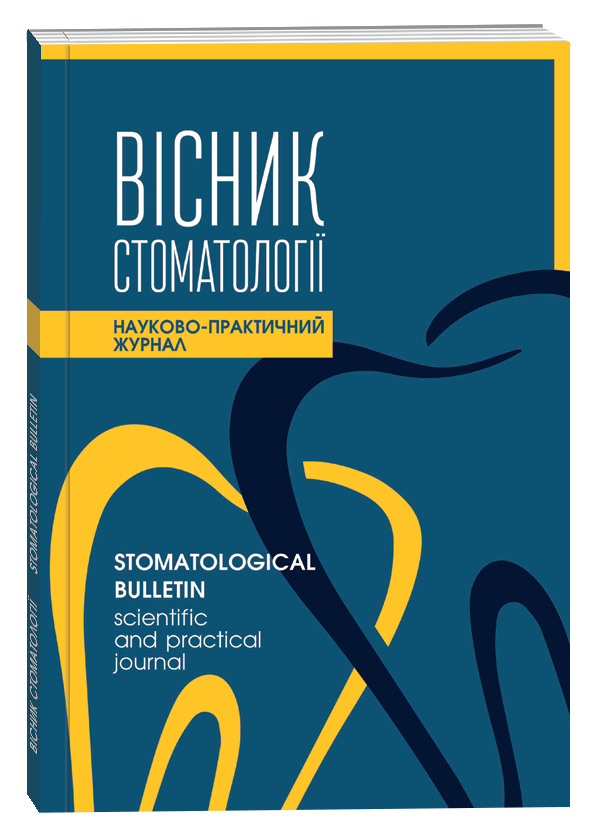CLINICAL FEATURES OF OCCLUSION AND TMJ FUNCTION IN PATIENTS WITH FACE MYOFASCIAL PAIN SYNDROME
DOI:
https://doi.org/10.35220/2078-8916-2019-32-2-69-73Keywords:
myofascial pain syndrome, temporomandibular joint, occlusion, diagnostics, clinic, differential diagnosticsAbstract
Myofascial pain syndrome (MPS) is an interdisciplinary prob-lem and, among all varieties of protopalgia, presents the great-est difficulties in diagnosis and treatment, both for neurologists and for dentists. The existing variety of MPS terminology in the literature (muscle pain dysfunctional syndrome, temporomandibular joint syndrome, Kosten syndrome, occlusive articulation syndrome) reflects the lack of common views, both on its distribution and on the role of each of the possible com-ponents.
All examined patients were divided into 3 groups.
Group I – patients who had no complaints against the organs of the oral cavity with orthognathic bite and do not have signs of myofascial pain syndrome (30 patients).
Group II – patients who had no complaints of the temporomandibular joint and masticatory muscles, but had signs of myofascial pain syndrome (45 patients).
Group III – patients with complaints of the temporomandibular joint and masticatory muscles with clinical signs of myofascial pain syndrome (23 patients).
When examining patients, the nature of the occlusal relationship was assessed: orthognathic bite, deep bite, direct bite, medial bite, distal bite open in the anterior section, cross bite.
A clinical study was conducted by visual inspection and exami-nation of the oral cavity. During external examination, patients paid attention to the ratio of individual facial areas (upper, middle and lower), the severity of nasolabial chin folds, mouth opening, the nature of the movement of the articular heads, the presence of noise in the joints during the movements of the low-er jaw, the state of the masticatory muscles, the opening of the mouth. When examining the oral cavity, the type of occlusion, the presence of cords of the mucous membrane of the vestibule of the oral cavity, the depth of the vestibule of the oral cavity were determined. When examining the dentition, attention was paid to the presence of premature contacts (centric and eccen-tric), the deformation of the dentition, anomalies of occlusion and the position of individual teeth, the presence of increased erasure of teeth, periodontal condition, the presence of dentures, carious and non-carious lesions of the teeth, the absence of teeth (full or partial). Held palpation of the chewing, temporal, medi-al and pterygoid muscles.
Determined that:
- The most significant differences in clinical indices in MPS be-tween the control group and patients who do not complain of the temporomandibular joint and masticatory muscles, but had signs of MPS were noted in the following clinical signs: a feel-ing of "fatigue" in the masticatory muscles when eating, the presence of "noise" when opening the mouth and the presence of lateral displacement of the lower jaw when opening the mouth.
- The number of clinical features distinguishing patients with complaints of the temporomandibular joint and masticatory muscles with clinical signs of facial myofascial pain may in-clude: the presence of premature contacts, orthodontic anoma-lies. The presence of painful seals in the masticatory muscles on palpation.
- The most significant clinical signs of occlusion and TMJ func-tion in patients with myofascial pain are: noise during move-ments of the mandible (+62.23 %); click of the temporomandibular joint when the lower jaw moves in the an-amnesis (+57.97 %); lateral displacement of the lower jaw when opening the mouth (+27.05 %); the presence of supra-contacts in the central, anterior and lateral occlusions (+22.23 %).
References
Мингазова Л.Р. Патогенез и лечение миофасциального болевого синдрома лица / Л.Р. Мингазова // Материалы клиниче-ской конференции молодых ученых ФППО ММА им. Сеченова «Актуальные вопросы клинической медицины». – М., 2002. – С. 54-58.
Морозова О.Г. Миофасциальная дисфункция и нарушение биомеханики позвоночника в генезе головной боли и головокруже-ния / О.Г. Морозова, А.А. Ярошевский // Международный невроло-гический журнал. – 2012. – №4 (50). – С. 44–56.
Myofascial pain syndromes in the maxillofacial area: a common but underdiagnosed cause of head and neck pain / L. Manolopoulos, P.V. Vlastarakos, L. Georgiou [et al.] // Int J Oral Maxillofac Surg. – 2008. – №37 (11). – Р. 975–84.
Wheeler AH. Myofascial pain disorders: theory to therapy / AH. Wheeler // Drugs. – 2004. – №64(1). – С. 45–62.









